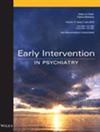Proof-of-Concept Pilot Study on the Integration of a Contingency Management Model to Address Substance Use Among Individuals Enrolled in Early Intervention Programs for Psychosis
Abstract
Background
Studies have reported high rates of alcohol and cannabis use and poor outcomes associated with substance use among individuals enrolled in coordinated specialty care (CSC) for first episode psychosis (FEP). Given these findings, substance use interventions within CSC would likely benefit individuals with FEP. This proof-of-concept study tested a standard and family-based contingency management (CM) model within CSC.
Method
Fourteen participants were recruited from a CSC programme for FEP to participate in standard CM and family-based CM for substance use intervention developed and refined by an advisory board comprised of key stakeholders. The CM intervention consisted of personalising CM by allocating participants to receive standard CM or family-based CM. Participants submitted urinalysis samples to assess alcohol and cannabis use across a 2-week warm-up phase, followed by a 12-week active CM phase.
Results
Approximately 60% of participants identified as an ethnoracial minority. At baseline, 78% of participants reported cannabis as the primary target substance and 64% opted into the family-based model. Eighty-four percent of urinalysis samples were submitted and 64% completed ≥ 8 weeks. Compared to baseline, substance use significantly decreased during the active CM phase (p < 0.003).
Conclusions
This pilot study suggests that a flexible CM model to address alcohol and cannabis, with the option for family involvement, may be feasible in CSC settings and increase abstinence among young adults with FEP. A high percentage of urinalysis samples were submitted, although most participants completed less than 12 weeks of CM. While findings show promise, additional modifications and pilot studies are needed to further optimise CM for CSC prior to conducting a larger efficacy trial.


 求助内容:
求助内容: 应助结果提醒方式:
应助结果提醒方式:


